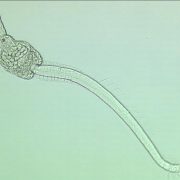New paper out
Parasites and stable isotopes: a comparative analysis of isotopic discrimination in parasitic trophic interactions
Thieltges, D. W., Goedknegt, M. A., O’Dwyer, K., Senior, A. M., Kamiya, T.
Oikos, 00: 1-11, doi: 0.1111/oik.06086
Stable isotopes are widely used to identify trophic interactions and to determine trophic positions of organisms in food webs. Comparative studies have provided general insights into the variation in isotopic composition between consumers and their diet (discrimination factors) in predator–prey and herbivore–plant relationships while other major components of food webs such as host–parasite interactions have been largely overlooked. In this study, we conducted a literature-based comparative analysis using phylogenetically-controlled mixed effects models, accounting for both parasite and host phylogenies, to investigate patterns and potential drivers in Δ13 Δ15N discrimination factors in metazoan parasitic trophic interactions. Our analysis of 101 parasite–host pairs revealed a large range in Δ13C (–8.2 to 6.5) and Δ15N (–6.7 to 9.0) among parasite species, with no significant overall depletion or enrichment of 13C and 15N in parasites. As previously found in other trophic interactions, we identified a scaling relationship between the host isotopic value and both discrimination factors with Δ13C and Δ15N decreasing with increasing host δ13C and δ15N, respectively. Furthermore, parasite phylogenetic history explained a large fraction (>60%) of the observed variation in the Δ1N discrimination factor. Our findings suggest that the traditional isotope ecology framework (using an average ΔN of 3.4‰) applies poorly to parasitic trophic interactions. They further indicate the need for a scaled rather than a fixed trophic discrimination factor framework along gradients of host δ15N. We also identified several conceptual and methodological issues which should to be considered in future research to help integrate parasitic interactions into a holistic isotope ecology framework across diverse trophic interactions.




Leave a Reply
Want to join the discussion?Feel free to contribute!